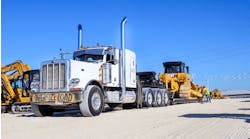With the COVID-19 pandemic came an upsurge of ecommerce sales and, in turn, parcel deliveries. While ecommerce consumption has been steadily increasing over the years, the pandemic expedited this growth. According to Chris Reamsnyder, vice president of sales, commercial vehicle for Raybestos, a brand of automotive brakes, projections suggest that this level of demand will not go away when COVID-19 subsides.
The rise in ecommerce and parcel deliveries means fleets with last-mile delivery (LMD) vehicles are in greater demand with more stops than ever before. They must be prepared for the increased wear and tear and have the proper maintenance routines in place to keep these LMD vehicles on the road and out of the shop.
Last-mile delivery vehicles
LMD vehicles are the final step in the delivery process; they deliver packages to their final destinations. Compared to medium- and long-haul vehicles, LMD vehicles are smaller in size making them easier to maneuver wherever packages need delivering – whether to a retail store or a residence. Raybestos’s Reamsnyder makes the comparison that most LMD vehicles are closer in size to a minivan than a traditional freight hauler, though some LMD vehicles are liftgate trucks.
As the demand for LMD vehicles continues to rise, more companies are shifting away from single trucks delivering large shipments to a central location, notes Beth Mooney, senior manager, marketing and ecommerce for Dana Aftermarket, a provider of commercial vehicle parts and products.
“This trend is driving significant growth in light and medium duty vehicle platforms like the Mercedes-Benz Sprinter, Ford Transit, and Nissan NV,” Beth says. “The light and medium duty classification of last mile delivery vehicles opens the door for owner operators and non-CDL drivers to get into localized package delivery. This, in turn, creates a new opportunity for repair shop owners to build their businesses, as service patterns shift away from large fleet repair contracts.”
In the midst of this shift, repair shops must ready their technicians for the increased number of LMD vehicles that will require maintenance and repairs.
Wear and tear
Due to the stop-and-go nature of LMD, parts and components such as drivetrain components, brakes, and tires, are easily and frequently worn down, requiring these vehicles to have routine maintenance checks following the guidelines of the OEMs’ manuals to ensure the vehicle is performing optimally.
Drivetrain components
The constant cycle of braking, accelerating, then braking again under which LMD vehicles operate places higher frequency fatigue cycles on drivetrain components, gears, bearings, etc. This could lead to damaging those components, notes Aravind Pillai, senior product manager for drive axle and electrification for Meritor, a global supplier for commercial vehicle manufacturers for specialty industries with a wide range of aftermarket solutions from drivetrain to brake systems.
Though most drivetrain systems are closed systems, meaning they are designed to operate for the life of the vehicle, Pillai explains, the key to keeping these drivetrain components properly functioning is lubrication.
“We have a lot of recommendations in our maintenance manuals,” Pillai says. “What oils should be used for what application, what’s the first oil change, what’s the [next] oil change, [et cetera].”
If a component does end up needing to be replaced, Mooney stresses the importance of installing quality parts that are “virtually maintenance-free and offer one-for-one replacement,” such as the Spicer three-piece driveshaft. Because Dana pre-balances the Spicer driveshafts, it cuts down on replacement time since technicians no longer need to use a balancing machine, she explains.
Brakes
The high frequency of stopping during LMD operations can quickly wear brakes down.
“Unlike Class 7 and 8 trucks that tend to have longer brake service intervals, last-mile delivery vehicles may require two or three brake jobs per year,” Raybestos’ Reamsnyder says. “In addition, because last-mile vehicles frequently drive through neighborhoods, the brakes not only need to have a long life, but they need to be quiet, too.”
Justin McCoy, senior product manager for disc brakes for Meritor, provides a list of items to check in order to maintain the braking systems on LMD vehicles.
- Check the brake fluid to make sure that it is free from moisture and grit.
- Check the wheel bearings for excessive movement.
- Check the rotors for irregular wear from side to side, tapering, and cracks.
- Check the brake pads for cracking or missing friction.
“Maintenance practices are not only important to extend brake system life on last-mile vehicles, but they help ensure the safety of the driver, passengers, drivers of other vehicles, and pedestrians,” Reamsnyder says. “Safety is paramount.”
Tires
LMD also has an accelerated effect on the tread life of tires.
Chris Novak, business leader, urban mobility for tire manufacturer Michelin North America, provides a list of qualities fleets should be looking for in LMD vehicle tires.
- Durability over extended mileage
- Ability to haul heavy loads with confidence
- Improved protection from impacts, punctures, and aggressions
- All-weather (or all-season) performance for rough, year-round work conditions, as well as wet braking in high-stress applications
Regardless of the tires a fleet chooses, all vehicles need to go through the appropriate tire maintenance checks. The number one item on that list should be checking the tires for the correct pressure.
“A tire that is 20 percent below the optimal air pressure is considered a flat tire,” Novak says. “A tire that is run under these conditions will experience casing fatigue that could lead to a catastrophic failure or a zipper rupture. If the tire has been run 20 percent underinflated, it should be removed from the vehicle and scrapped. Under CSA guidelines, a tire that is found to be operating with less than 50 percent of the maximum pressure (sidewall) is in out of service condition.”
On top of always checking tire pressure, visual inspections should be conducted to look for signs of irregular wear in the tread or shoulder areas of the tires. Tires should be kept clean by washing them with warm soap and water to help prevent premature aging or deterioration. Additionally, tires should not be mixed, especially across the axle. Fleets should ensure all tires on a vehicle are matched with the same tread depths, tread patterns, and height or diameter, Novak notes.
To the future
The rise in demand for LMD not only means fleets must keep an eye on maintenance it also means they must keep an eye on the future. As the use of LMD vehicles grows, features and designs are adapting.
Safety features, such as back-up cameras and lane departure alerts, are being added to LMD vehicles, and on some are already an option.
Brian Tabel, executive director of marketing for Isuzu Commercial Trucks of America, a commercial vehicle and diesel engine manufacturing company, notes that Isuzu has added these devices as optional features to help reduce accidents and keep drivers aware of their surroundings.
The Isuzu LMD vehicles also have a low, cab-forward design, meaning the vehicle has a longer body with a similar footprint to a conventional vehicle, but has the ability to haul more cargo. Though space is a necessity for cargo, the smaller the LMD vehicle, the better it performs in terms of maneuverability, which is especially important in situations such as crowded drop-off locations.
Another development with LMD vehicles is the move to electrification. With advancements in battery technology over the last 10-15 years, the industry is reaching a point where it makes economic sense to switch to using electric vehicles, Meritor’s Pillai notes.
“There [are] several projects going on with multiple OEMs that are kind of in a race,” Pillai says. “A technology race to launch products here in the next year or two. We’re not seeing that much already on the road, but there’s a lot happening right now that will change the dynamics in the coming years.”




